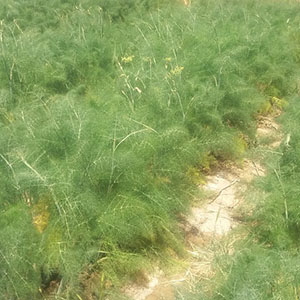Fennel outperforms ajwain and anise in the saline environment: physiological response mechanisms in germinating seeds and mature plants

Accepted: 17 June 2022
HTML: 226
All claims expressed in this article are solely those of the authors and do not necessarily represent those of their affiliated organizations, or those of the publisher, the editors and the reviewers. Any product that may be evaluated in this article or claim that may be made by its manufacturer is not guaranteed or endorsed by the publisher.
The potential of different medicinal species as alternative crops for saline conditions needs to be explored. Comparative physiological responses of germinating seeds and mature plants of three genotypes of anise (Pimpinella anisum L.), fennel (Foeniculum vulgare Mill.), and ajwain (Trachyspermum ammi L.) to salt were studied in a 2-year field experiment using 0 and 100 mcM, and a laboratory experiment using 0, 25, 50, 75, 100, and 125 mM NaCl. Catalase and ascorbate peroxidase activities increased in the salt-stricken plants of all genotypes, but only peroxidase activity of the salt-treated plants of anise genotypes and two of the fennel genotypes increased under field conditions. Chlorophyll and K+ concentrations of all genotypes decreased, but proline and Na+ concentrations and Na+/K+ increased under saline conditions. Dry mass, grain yield, and essential oil yield decreased in the salt-exposed plants across all genotypes and species. Germination, root, and shoot length were suppressed upon exposure to saline water. Despite the increasing trend of the proline and polyphenol concentrations and catalase and peroxidase activities, ascorbate peroxidase activity of germinating seeds decreased with an increase in NaCl concentration. Smaller adverse effects of salt on fennel germination attributes, grain, and essential oil yields were evident. Moreover, more significant activities of antioxidative enzymes and maintained Na+ and Na+/K+ of salt-stricken fennel plants were observed. These findings indicate that fennel germinating seeds and mature plants have a greater ability to withstand salinity than the other examined species.
Highlights
- Differential salt-induced alterations in ionic status of mature plants of anise, ajwain, and fennel.
- Boosted antioxidative enzymes activities in the stressed plants of different species.
- Greater grain yield and essential oil of stressed fennel plants compared to anise and ajwain.
- Fennel and ajwain mature plants benefit from a stronger antoxidative defense to withstand salinity.
- Polyphenols and proline accumulated in the germinating seeds of fennel and ajwain contributes to salt tolerance.
How to Cite

This work is licensed under a Creative Commons Attribution-NonCommercial 4.0 International License.
PAGEPress has chosen to apply the Creative Commons Attribution NonCommercial 4.0 International License (CC BY-NC 4.0) to all manuscripts to be published.

 https://doi.org/10.4081/ija.2022.2096
https://doi.org/10.4081/ija.2022.2096



